Clubs Offering:
On April 1-3 in Ocala, Florida, top agility dogs from accross the country will gather for the 2022 National Agility Championship at the World Equestrian Center. Many people may not be familiar with agility competitions, where dogs navigate through an obstacle course while racing against the clock. Even for those who have heard of the sport, acting as a simple spectator can be a little intimidating.
We are here to fill you in on the basics of watching an agility event — including a breakdown of each obstacle and how scoring works. Who knows, you may just be inspired to start training your pup after this mini introduction.
Courses typically have between 14-20 obstacles. Here are several you’ll run into:
1. Jumps — These vary from course to course, but a dog must leap over the bar without displacing it. The height of the dog determines the heights of each jump. FYI: Dogs are measured before the competition.
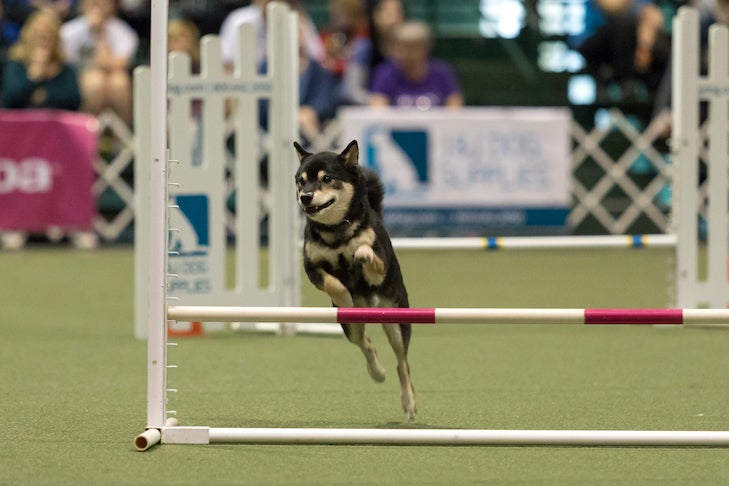
2. Dog Walk — A dog must run up the ramp on one side, scamper across the top horizontal plank, then run down the ramp on the other side, being sure to touch the “contact zone” (usually painted a bright yellow) at the bottom of the board as they exit.
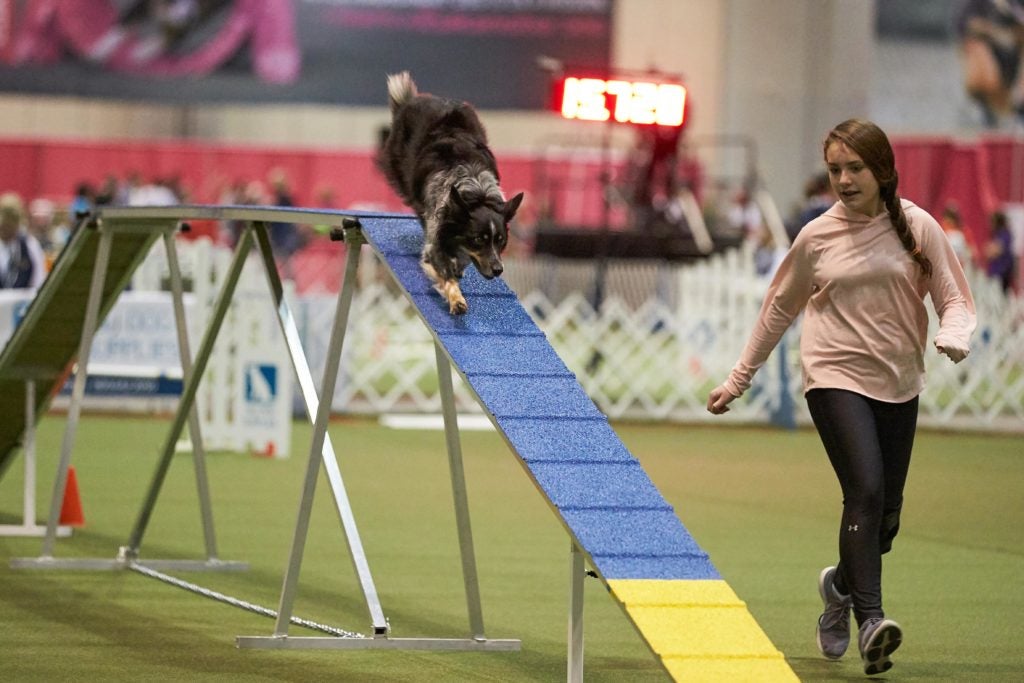
3. Weave Poles — Comprised of six to 12 upright poles, a dog must enter to the right of the first one and weave through each of the others quickly without missing a pole. It is considered one of the trickiest obstacles to master.
4. Tire Jump — A dog must jump quickly and cleanly through the opening of the tire. The height of the jump is based on the height of the dog.
5. Open Tunnel — The objective is simple: A dog must enter from one side and exit through the other. Although the tunnel is often curved so the dog can’t see the exit from the entrance, given how straightforward it is, the Open Tunnel is often considered a great place to start when training.
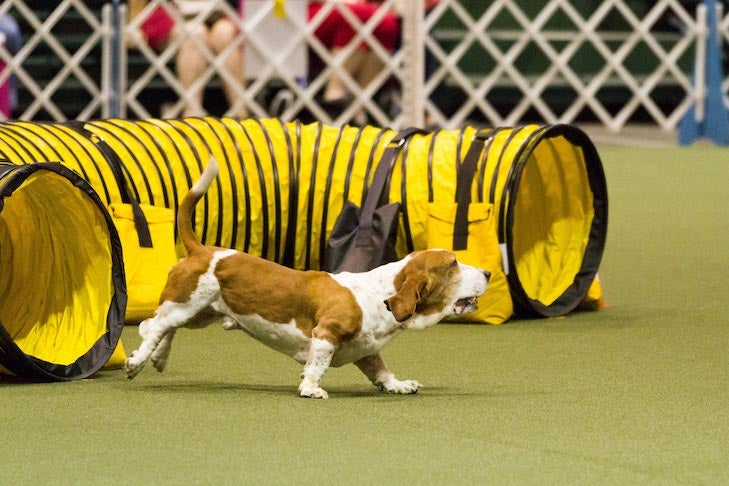
6. Seesaw — Unlike the seesaws you may have played on as a child, dogs don’t get a partner for this obstacle. After running up the board and down the other side as it pivots with their momentum, a dog must touch the “contact zone” with at least one toenail as they descend.
7. A-frame — Made up of two broad ramps hinged together, a dog must quickly scale the structure, scramble over the apex, and touch the “contact zone” while descending.
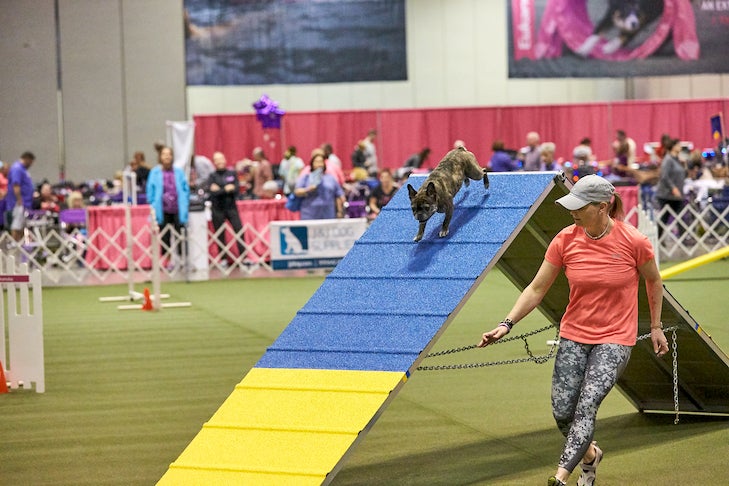
8. Pause Table — Used to slow the team’s forward momentum, a dog must pause on the table for five consecutive seconds.
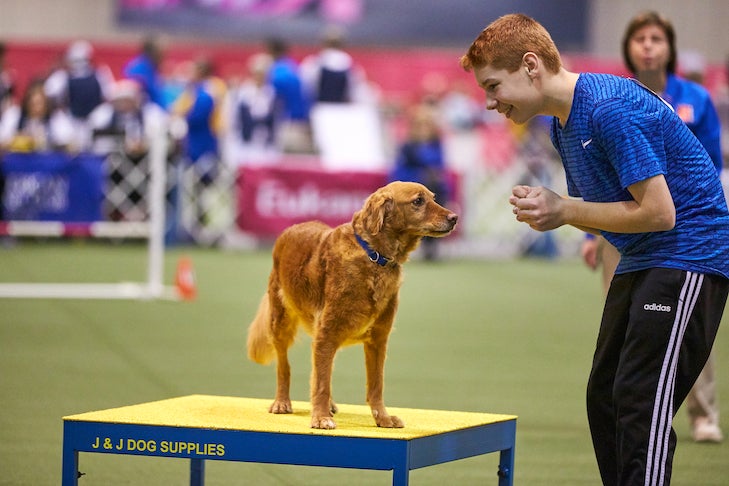
The goal of every competitor is to earn what is called a “qualifying score”. These scores count towards certain titles. As long as a run is under the SCT and free of faults, it is a qualifying run (also called a “Q”). In higher levels of agility competitions you need several Qs. In AKC agility for example, QQs are required to reach the level of Master Agility Champion.
In most organizations (such as in AKC agility), there is a maximum time allowed for dogs to run a course. It is called the Standard Course Time (SCT). The SCT is calculated so that it allows nearly all dogs to easily make it. Any dog that is running instead of walking and does not get overly distracted will usually be within the given time frame.
On the teeter the dog needs to touch the yellow as the teeter hits the ground. On the dogwalk and A-frame, the dog has to touch both contact zones at the beginning and the end of the obstacle in order to get a good score. On the pause table, the dog has to stay for a count of 5.
Dog agility scoring is not easy to understand for beginners. As a rule of thumb, remember that your dog needs to take all obstacles exactly in the order they are shown (without skipping obstacles, taking additional ones or taking the same obstacle twice). He also should not make a mistake in navigating each individual obstacle (such as by dropping a bar).
An Activity for Every Dog
One of the great aspects of agility trials is the wide variety of events. Every breed can take part! Agility trials have six different categories in which a dog can compete, including Standard, Jumpers with Weaves, Time 2 Beat (T2B), and Fifteen And Send Time (FAST). In addition, AKC offers the Premiere Standard and Premiere Jumpers with Weaves classes for Masters level dogs to compete on international-style courses.
Each of these categories have different levels that can be entered based on the dog’s experience. The first level, Novice, is for dogs just starting out in the sport. In Novice, there are 14-16 obstacles, and the course is less intensive for handler and dog. The next level, Open, increases the difficulty of the course and the number of obstacles to 16-18. The highest level, Excellent or Master, is for dogs who have successfully completed open level. This level combines tricky routes and an increase to 18-20 obstacles to challenge the dog’s stamina.
In each event, the dogs are separated into classes based on jump height. Dogs are measured to the point of their shoulder and must jump in the class for their height or in a higher class. The Preferred division offers modified standards of lower jump heights and additional seconds on course for dogs who need it.
4 Dog Agility Competition Rules to Know
Since agility was first introduced at Crufts 1978, its structure has remained almost the same. Its a form of dog competition, where the dogs fitness and the handlers ability to train and direct the dog over and through certain obstacles are tested.
It is fast, furious and a firm favourite with competitors and spectators alike. Your dog does not have to be a pedigree dog to take part, but it must be registered with The Kennel Club on either the Breed Register or the Activity Register.
If you decide that agility is a suitable activity for you and your dog, your next step is to receive some expert training. Whichever competition you choose, your dog will be a happier pet for being trained. What is agility?
Agility is an action–packed rollercoaster of excitement for you and your dog. Its made up of various obstacles for your dog (not you!) to run through, jump over, and weave in and out of – and all against the clock! Not only does agility test your dog’s fitness, it also measures your ability as a handler to direct your dog through the course. What do I need to know to take part?
Preparing your dog to compete successfully will take a little longer than the formal requirements. It is essential that your dog is fully socialised and that you have effective control at all times, especially as your dog will be competing off lead. For safetys sake, it is recommended that dogs do not start training on equipment until they are at least 1 year old. How can I find a training club?
Plenty of regular practice is essential when preparing for agility competitions, but supervised training at an agility class is just as important. There are a number of training clubs across the country. Find one near you by using our Find a Club service. My dog is blind. Can I still compete? It is not advised that blind dogs compete in Kennel Club activities as it is not in their best interests. This specifically relates to dogs that have no sight whatsoever and does not apply to dogs with partial vision. Owners are reminded to consider the welfare of their dogs at all times. My dog is docked. Can I still compete?
Defra (the Department for Environment, Food and Rural Affairs) has clarified that dogs with docked tails may take part in all agility shows in England and Wales, including those where the public have paid for admission. There is no change to the position in Scotland, where legally docked dogs have never been banned from events where the public pays to enter.
The clarification confirms that ‘legally docked dogs’ taking part in agility qualify for an exemption from a general ban on the showing of docked dogs. It means that working dogs do not have to be excluded from the various agility shows which are held within larger events such as country fairs, where the public pays for admission. They are also able to participate in agility finals at events such as Crufts, Olympia and Discover Dogs.
The Animal Welfare Act banned the docking of dogs’ tails after 6 April 2007 (after 28 March 2007 in Wales, and 30 April 2007 in Scotland). In England and Wales (but not Scotland), docking is still allowed for certain types of working dog – essentially Spaniels, Terriers and hunt, point and retrieve (HPR) breeds – if carried out by a vet who has been given specific evidence that the dogs will be used for certain types of work, primarily as gundogs.
The Act also banned the showing of dogs with legally docked tails at shows in England and Wales where members of the public pay an admission charge (in Scotland there is a total ban on docking but no prohibition on showing dogs with docked tails). However, there is an exemption (in England and Wales) if the dog is shown ‘only for the purpose of demonstrating their working ability’, even where the public pay an entrance charge.
The clarification from Defra reads: ‘As you are aware, there is a ban on the showing of docked dogs at events to which members of the public are admitted on payment of a fee, however, there are exemptions from this ban. The ban does not apply to certified docked working dogs being shown only for the purpose of demonstrating their working ability (e.g. in agility trials). A certified docked working dog cannot be shown for any other purpose.’
Dogs which were docked earlier than 6 April 2007 (or the equivalent dates in Wales and Scotland) are unaffected by the legislation and can be shown at any type of show. Illegally docked dogs may not be entered in any Kennel Club event.
Agility classes involve both jumping and agility courses. Each course features a variety of agility obstacles, however jumping courses do not require the dogs to undertake the see-saw, dog walk or A ramp obstacles. Learn more about agility course obstacles.
An agility competitor and their dog advance from grades 1-7; grade 1 is the lowest level and grade 7 the highest. Competitors and dogs that are new to agility will be able to enter classes suitable for grade 1. As you and your dog improve you may be able to progress to the next grade. There are two ways in which a competitor can progress; the first is progression on wins and the second is through points progression.
Other classes that are scheduled at an agility show may fall under the title of special classes. Special classes are classes where the definition for eligibility to compete is not per Kennel Club regulations, the marking of the class differs from standard Kennel Club marking or the course design is non standard.
Classes such as these – with unusual names like helter skelter, gamblers, time, fault and out, power and speed, ABC (anything but a Collie), any size and pairs – will be clearly defined in the schedule along with details of eligibility. Please note: you cannot claim Agility Warrant points or progress from special classes.
An agility competitor and their dog advance from grades from 1-7, with grade 1 being the lowest level and grade 7 the highest. There are two ways in which a competitor/dog can progress from one grade to the next. Progression on wins
Progression through the grades can be achieved through a certain number of wins at the relevant grade. A certain number of these wins must be in agility (not jumping) classes.
Results from combined classes (where there could be up to seven grades in one class) will only count towards progression from the dogs current grade.
A 1st prize or other prize win is one gained in a standard class at any show licensed by The Kennel Club (i.e. special classes and invitational events are excepted). Only a 1st place with a clear round completed within the course time set by the judge will count towards grade progression. If you progress on a win you remain at the same grade for 25 days after the win. Following this period, you will progress to the next grade. For any shows taking place after the 25-day period, it is the competitors responsibility to notify the show secretary of a change in grade, in writing, a minimum of 14 days before the show. Points progression
At the handlers discretion, a dog may progress to grade 4 by winning 100 points at each grade. A minimum of 50 points must be gained in agility (not jumping) classes in the relevant grade. If this method of progression is selected, the handler must ensure the show secretary signs the dogs agility record book at the first show entered at the higher grade. There is no time limit on this progression, however, once a dog has progressed, it cannot return to a previous grade. Progressing in agility – frequently asked questions